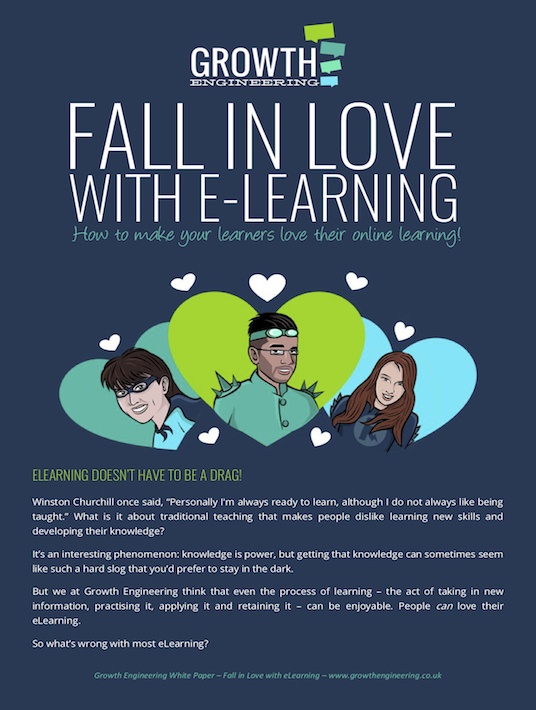2 Learning Theories That Will Help You Get People To Fall In Love With eLearning
Want to get people to fall in love with eLearning? Let’s start by studying the theory of Bloom’s Taxonomy about the different levels of learning, as well as the user experience hierarchy of needs!

1. Bloom’s Taxonomy
Bloom’s Taxonomy explains that there are different levels of learning, from in-depth ‘creating’ learning tasks, down to more basic ‘knowledge’-based approaches.
Good Instructional Designers (clever clogs who write eLearning units) know that Bloom’s Taxonomy is the best way to create learning objectives that really get learners engaged with the material, working hard, and learning new concepts.
As you can see from the diagram, the lower levels represent basic Knowledge – retrieving or remembering previously learned material. Learning objectives at this level include defining key terms, listing steps in a process or repeating something heard or seen.

Learning objectives at the Comprehension level are based around processing new information. This requires learners to use the information they just learned to answer basic questions.
At the Application level, learners are asked to solve new problems by applying what they have learnt without having to be prompted to novel situations in the workplace.
Analysing involves distinguishing between facts and inferences; learning objectives involve separating concepts into component parts, e.g. “Gather information about the finance department’s problem and select the appropriate tool to solve it.”
Learning objectives at the Evaluation level involve making judgements about the value of ideas or materials, e.g. “From the three interview scenarios, select the best candidate to hire.”
Creating involves building a structure or pattern from diverse elements. It involves pulling parts together to solve a whole problem, with an emphasis on creating something new. E.g. “Taking into account what you have learnt about Sparky Electrics on the previous screens, devise an appropriate training programme.”
As you can see, the steps in Bloom’s Taxonomy really target different kinds of knowledge – from straightforward information retention all the way to creation of new processes through a deep understanding of what has been learnt.
A lot of eLearning focuses on the lower steps of learning – knowledge and comprehension. This means that the learner isn’t encouraged to get a very deep level of understanding, meaning they’re not as involved in their learning or as interested. Sure, being able to remember a fact is great, and getting the quiz questions right can boost your confidence. But how much more engaged and invested in your learning will you be if you can see how far you’ve come, from being taught the basics through to designing your own processes or solving problems by thinking up new solutions?
2. User Experience Hierarchy Of Needs
That’s one theory of learning that will help to get people loving their learning. The user experience hierarchy of needs is another. This pyramid explains that it’s not just what the learner is being taught that will affect their enjoyment of the learning; it’s also how they are taught.

Picture a 30-screen eLearning unit, each screen containing a few paragraphs of text, with 10 questions at the end to check what you’ve learnt.
Now imagine an eLearning unit containing the same information, but presented in a mixture of video, audio and bullet points, with practice scenarios, interactive learning, and different question formats, from multiple choice and drag-and-drop exercises to written answers and longer assignments.
Which do you think would be more enjoyable? Which would you be more likely to go back to and carry on with the next eLearning chapter or unit?
The user experience hierarchy of needs explains why we get more enjoyment from interactive eLearning units than we do from traditional, run-of-the-mill eLearning.
Bog-standard eLearning courses satisfy the first few levels of the pyramid. They modules are functional, straightforward, usually easy to use and hopefully reliable.
They are also convenient – you can login on your computer and start learning. But is it pleasurable? Does the experience of learning stick in your mind, over and above what you actually learn? Do you say to your colleagues, “I took the eLearning unit on fire safety yesterday. Each screen had a load of text on it and then I answered 10 questions. It was so much fun!”?
How about: “I took the eLearning unit on fire safety yesterday. The videos were great, and the drag and drop questions were cool. I even got extra points for getting 5 questions in a row correct, and a ‘Smokin’ hot!’ badge for completing the unit. You should try it!”
If learning is good, appropriate, applicable, and pleasurable, learners will fall in love with their learning once again. But what about the top of the hierarchy – how can learning be meaningful and have a personal significance?
Simply put, most learning isn’t especially meaningful, at least in the sense that we mean it here. Sure, learners can answer questions in relation to their personal experiences and apply their knowledge to their circumstances. But this isn’t the same as the learning having personal significance; it’s just their answers that are applicable to their work life.
Good eLearning, on the other hand, uses learners’ experiences directly and actually incorporates these thoughts and scenarios into the eLearning unit. The Discovery Method of learning – what we call our ground-breaking technique – gets learners inputting all sorts of information about their job directly into the learning, which is then referenced throughout the course.
For example, the eLearning could ask a user to input their name, job role, and company name. The unit is then made personally significant to the learner by referring back to these details.
The instruction in a standard eLearning unit may be: “Take time to reflect on this information and how it may relate to your current role.”
Whereas the instruction in a good eLearning unit might be: “[Timothy], take a moment and think about how this information on laws and ethics applies to you in your role as [Sales Manager] at [BlinkBox]. Write your thoughts in the text box on screen.”
The information Timothy provides is then compiled into a worksheet to be downloaded at the end of the eLearning unit, providing him with a ready-made plan of attack that he can begin to apply to his job immediately.
See the difference?
If you want to learn more about how you can get people to love their eLearning, download the eBook Fall In Love With eLearning: How To Make Your Learners Love Their Online Learning!









